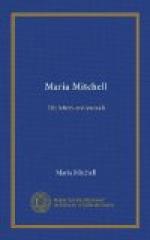“There is always some one to be found in every gathering who will not submit to law. At the time of the total eclipse in Iowa, in 1869, there passed in and out among our telescopes and observers an unknown, closely veiled woman. The remembrance of that occasion never comes to my mind without the accompaniment of a fluttering green veil.
“This time it was a man. How he came among us and why he remained, no one can say. Each one supposed that the others knew, and that there was good reason for his presence. If I was under the tent, wiping glasses, he stood beside me; if the photographer wished to make a picture of the party, this man came to the front; and when I asked the servant to send off the half-vagrant boys and girls who stood gazing at us, this man came up and said to me in a confidential tone, ’They do not understand the sacredness of the occasion, and the fineness of the conditions.’ There was something regal in his audacity, but he was none the less a tramp.
“Persons who observe an eclipse of the sun always try to do the impossible. They seem to consider it a solemn duty to see the first contact of sun and moon. The moon, when seen in the daytime, looks like a small faint cloud; as it approaches the sun it becomes wholly unseen; and an observer tries to see when this unseen object touches the glowing disc of the sun.
“When we look at any other object than the sun, we stimulate our vision. A good observer will remain in the dark for a short time before he makes a delicate observation on a faint star, and will then throw a cap over his head to keep out strong lights.
“When we look at the sun, we at once try to deaden its light. We protect our eyes by dark glasses—the less of sunlight we can get the better. We calculate exactly at what point the moon will touch the sun, and we watch that point only. The exact second by the chronometer when the figure of the moon touches that of the sun, is always noted. It is not only valuable for the determination of longitude, but it is a check on our knowledge of the moon’s motions. Therefore, we try for the impossible.
“One of our party, a young lady from California, was placed at the chronometer. She was to count aloud the seconds, to which the three others were to listen. Two others, one a young woman from Missouri, who brought with her a fine telescope, and another from Ohio, besides myself, stood at the three telescopes. A fourth, from Illinois, was stationed to watch general effects, and one special artist, pencil in hand, to sketch views.
“Absolute silence was imposed upon the whole party a few minutes before each phenomenon.
“Of course we began full a minute too soon, and the constrained position was irksome enough, for even time is relative, and the minute of suspense is longer than the hour of satisfaction. [Footnote: As the computed time for the first contact drew near, the breath of the counter grew short, and the seconds were almost gasped and threatened to become inaudible, when Miss Mitchell, without moving her eye from the tube of the telescope, took up the counting, and continued until the young lady recovered herself, which she did immediately.]




